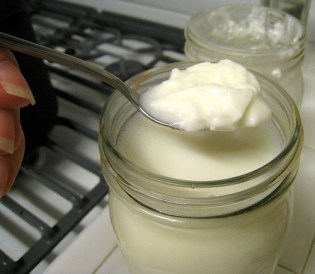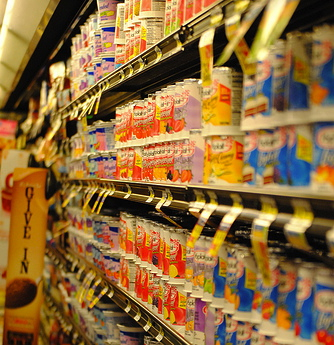Does this title sound familiar? This is part of an ongoing effort to highlight the ways in which many of our most common foods have morphed into industrialized products in recent decades. See Not your grandma’s milk and Not your grandma’s strawberries for more.

Photo by Anthony Albright.
Nishanga Bliss, a holistic health practitioner, has been making her own yogurt on and off since the 1980s. She learned from a Swiss neighbor, liked the results, and was delighted to avoid accumulating all those plastic containers. The author of the forthcoming Real Food All Year, who also teaches yogurt-making classes, recommends making this cultured dairy product with whole milk. “When you make your own you can tinker with the taste and texture,” says Bliss. Another advantage of DIY yogurt: It can ferment longer than commercial products, thus eliminating all the lactose, which is beneficial for those with an intolerance.
Bliss is among a growing group of people who are rethinking buying industrial versions of popular health foods — such as yogurt — in favor of making their own with minimal processing and additives. Bliss believes the beneficial bacteria in yogurt — also known as probiotics — can do your gut a world of good, by protecting against intestinal infections and enhancing immune functioning.
Yogurt was introduced to the mainstream American palate back in 1942, when Dannon started producing European-style cultured milk. But it had so few takers for its tart taste that five years later the company began adding fruit to the mix to entice more customers. These days, it’s not just fruit that’s found in those plastic tubs, but also sugar, high-fructose corn syrup, artificial sweeteners, colors, and flavors, as well as thickeners, stabilizers, and preservatives.
The culture wars
In fact, most yogurt has become a highly industrialized food. Consider the color-saturated stuff sold in garish plastic tubes designed to grab the attention of children (and their parents). In an NPR interview about his book Food Rules, author Michael Pollan describes his “don’t eat anything your grandmother wouldn’t recognize as food” test to determine whether this yogurt is even food. Here’s his take on the popular portable product known as Go-Gurt:
Imagine your grandmother or your great-grandmother picking up this tube, holding it up to the light, trying to figure out how to administer it to her body — if indeed it is something that goes in your body — and then imagine her reading the ingredients. Yogurt is a very simple food. It’s milk inoculated with a bacterial culture. But Go-Gurt has dozens of ingredients.
While researching her book, What to Eat, nutritionist Marion Nestle found some 400 different kinds of yogurt in a local store but was hard pressed to find a few plain, unflavored tubs with nothing added to the milk product beyond the bacteria cultures it requires. “Plain yogurt can be a nutritious and satisfying snack or accompaniment to meals,” Nestle notes in her tome on healthy consumption. “But it is easier to sell — and is more profitable — when it gets turned into a product of infinite variety and cloying sweetness.”
Indeed, the market for commercial, mass-produced yogurt is growing by leaps and bounds. For example, in each of the last three years, sales of Greek yogurt have grown more than 100 percent, according to a recent Los Angeles Times story, which notes that producers of this style of yogurt alone now rake in more than $1 billion in revenue a year in the U.S. Leading supermarket brands for conventional yogurt include Yoplait and Dannon; Chobani and Fage are the biggest sellers of Greek yogurt.
Dairy producers, who want to see as much of their product as possible in the market, are keen on what’s known in the business as “line extension,” writes Nestle. That can mean fruit-flavored yogurts that have no real fruit in them and others that stretch the milk with thickeners to extend shelf life and lower costs.
It’s this industry tampering that leaves a sour taste in the mouths of people like Michele Simon, author of Appetite for Profit and occasional Grist contributor. “Yogurt as a health food is one of the biggest scams by the food industry, right up there with orange juice,” she says, adding that the way it’s marketed to kids is “just as bad as sugary cereals.”
Critics of yogurt as a health food also point out that the claims surrounding probiotics are far from proven, as Tara Parker-Pope notes in a summary of research on this subject for the New York Times, which also recounts recent class-action lawsuits against manufacturers for misleading health claims surrounding yogurt.

Making your own yogurt is easy and economical. (Photo by Dvortygirl.)
The alternatives
Of course, some commercial yogurt makers are working on alternatives to the mass-produced norm. Stonyfield Farm, while now a division of the French conglomerate Groupe Danone, brought organic yogurt to the mainstream. And a former Kraft branding consultant of Greek background recently rolled out a product called Better Whey of Life Greek Yogurt, made with whey protein from grass-fed cows.
Meanwhile, some small, artisan yogurt producers are succeeding by creating a product much like you might make at home. Take Benoit de Korsak, an artisan who sells French-style yogurt under the Saint Benoit Creamery label in farmers markets, co-ops, and health food stores in California. De Korsak has been producing his own yogurt since 2004 and has also seen a steady increase in sales, even if that still only amounts to about 10,000 quarts and cups of yogurt a week.
De Korsak is both passionate about his product and frank about the challenges of working at a small scale. For starters, industry giants try to lock dairy farmers into exclusive contracts to shut out small-scale producers, a practice he’s dealt with firsthand. He’s also been approached by large yogurt companies eager to buy his business. Though flattered, de Korsak is determined to stay independent and protect the integrity of his product.
There are other challenges to making yogurt locally — maintaining consistency and appearance, sourcing sufficient fruit, fridge life, dealing with recyclable returns — but the hard work is worth it, says de Korsak. “I’m fortunate to live in an area where there’s a local source for organic dairy and fruit, and a community and consumers who understand the true cost of food and are willing to support what I do.”
Not that everyone can afford locally produced artisan yogurt. Which is why making it at home might catch on.
Yogurt is essentially just milk fermented (or soured) with bacteria or culture that converts the sugar lactose in milk into lactic acid, which results in yogurt’s signature creamy texture and tangy taste. The bacteria most frequently used in yogurt sold in the States include Lactobacillus bulgaricus, Streptococcus thermophilus, Lactobacillus acidophilus, and Bifidus species.
Vanessa Barrington, author of D.I.Y. Delicious, prefers to make a batch in a quart-sized mason jar kept in a warm water bath in the oven overnight. She also recommends starting with non-homogenized, whole organic milk from a local dairy for best results. “Making yogurt is easy,” she says. “And since organic milk is less expensive than organic yogurt, you can save money too.”
See Barrington’s yogurt recipe here.



